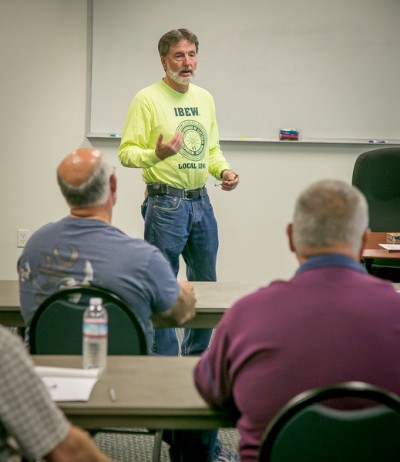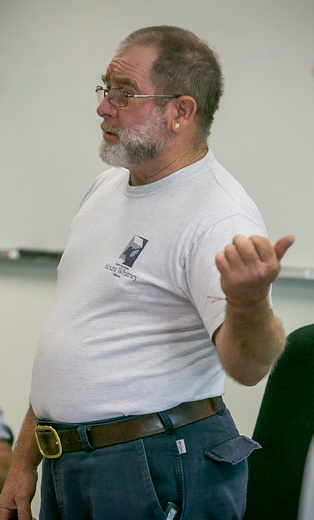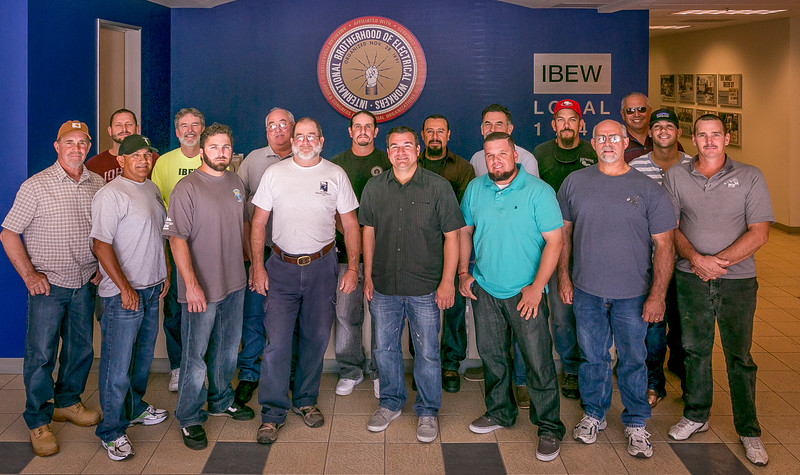For many members and stewards on the physical side of IBEW 1245, writing, practicing and delivering speeches isn’t something they do every day…. And there’s usually a reason for that.

Hold the Pull Committee member Dan Mayo explains how delivering safety presentations helped him conquer his fear of public speaking.
“I used to be scared to death of public speaking. Just the idea of it was horrific to me,” said Dan Mayo, a seasoned Hold the Pull Committee member who has delivered numerous safety presentations since joining the committee. “But I also have a real fear of getting hurt and dying on the job. The safety committee for me was the bridge – it helped me get over my fear of public speaking and learn to deliver a message about being safe at work.”
Mayo’s public speaking phobia isn’t unique, which is why the IBEW 1245 Peer Safety Committees decided to host a new kind of training, to help other safety stewards practice and improve their communications and public speaking skills. The training aims to prepare the stewards to lead peer safety presentations at different worksites across IBEW 1245’s jurisdiction.
“It’s not a natural thing for most of us. It’s a skill we need to develop,” IBEW 1245 Safety Rep Rich Lane told the 15 safety stewards who came to the preliminary training on October 9th at Weakley Hall. “This peer communication training is something new that we’ve never done before, and it’s the result of some changes in the program.”
And by changes, Lane really means extraordinary growth. Last year, the Hold the Pull, Keep the Clearance and Control the Pressure peer safety committees did 25 worksite safety presentations. They expect to double that number in the coming year, because word is getting around and more and more employers are inviting the committees to come out and do presentations. There simply aren’t enough committee members to cover them all, which is why they’ve enlisted the safety stewards to get involved and take on some of these presentations themselves.
“This peer safety program is run and operated by you — the peers – so now we’re asking you to step up and help get our safety message out there,” Lane told the stewards. “We know it’s not easy. Thanks for responding and stepping up to this. We really appreciate what you guys do.”
Retired troubleman John Kent partnered with Lane to facilitate the training, which focused on keeping the message simple, and providing tools and tactics that can work in any presentation-from a small group conversation to a large-scale pitch in front of hundreds.
To kick off the training, the facilitators asked the stewards to come up to the front of the room, explain why they got involved in the peer safety program and share their experience (if any) with public speaking.. For some attendees, this self-introduction was their first experience speaking in front of a group. It helped them shake off a bit of the initial fear and understand that nervousness is natural. Lane was surprised and impressed with how well the stewards did given their lack of preparation and experience, but explained that it’s always easiest to tell your own personal story.
The self-introductions served as an appropriate segue into the first exercise of the day – developing a personal safety message. Most of the stewards had thought about their message in an informal way, but by taking the time to write it out on paper, they could organize their thoughts and focus on the most important and meaningful elements of their own stories.
Kent emphasized that sharing first-hand, personal experience is the most powerful way to get others to take a fresh look at their own safety. Old habits, short cuts and tunnel-vision can be dangerous. By taking the time to compose and present a structured narrative, the stewards were able to polish their stories. They also got a chance to listen and learn from one another.
Kent and Lane then demonstrated the emotionally-charged presentation that the Hold the Pull committee members have crafted and refined over the years. Although the presentation has proven effective, the facilitators encouraged the stewards to view it as a starting point. The power of their own pitches will depend on their success in delivering their personal stories with passion and commitment.
After lunch, the stewards worked to develop an “elevator pitch” – a brief but impactful speech that can be delivered in just one minute (the time it takes to ride with someone in an elevator) and hits all the key points about their specific peer safety programs. Lane prompted some of the stewards to engage in a brief role-play to share their elevator pitches with the whole group. The stewards also had a chance to learn from the successes of the experienced committee members – as well as the failures that helped the committee re-focus and reframe the presentation to make it more effective.
Another peer safety communications training will be coming up in the near future, said Lane. He hopes that the feedback from this initial session will help to streamline and improve future trainings. To get involved in the peer safety program, email Rich Lane at RVL5@ibew1245.com.

